SUPERCHARGE YOUR Online VISIBILITY! CONTACT US AND LET’S ACHIEVE EXCELLENCE TOGETHER!
There’s a common notion among traditional SEOs in the modern-day that SEO has become a lot tougher in recent days. That is to build authority and a backlink profile is the only way you beat your nearest competitor in SERP rankings. If your everyday SEO job makes you feel like this, I would urge you to take a moment and look at the following example.

For a simple keyword like “business outsourcing” which is probably a higher intent keyword, an IT Outsourcing Company named boutsourcing.com is impressively ranking in 3rd position beating big players like Wikipedia and a Government website, despite the fact that its authority or its backlink profile is nowhere near the domains it is competing within the SERP.
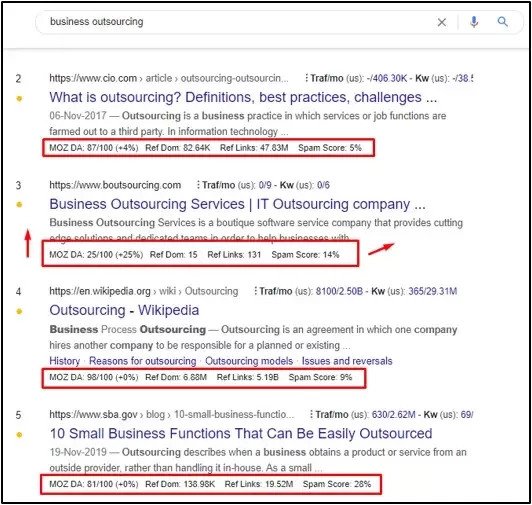
This is because Domain Authority doesn’t matter anymore; relevance does. Google has been emphasizing this point since the beginning.
A person who is searching for the keyword “business outsourcing” has a high probability that he/she is probably looking for relevant service providers. Since boutsourcing’s entire website is about business outsourcing, it is more sensible to include their page high in the SERP along with other domains that merely provide informational content.
Being a search engine which is processing millions of search queries every second, Google can make these assumptions about a keyword’s intent based on pure statistics alone.
Learn more about how to optimise for Keyword intents using Customer Journey Map.
To surprise you even further Googler John Mueller has himself stated that Domain Authority doesn’t exist as a metric in Google’s algorithm.
Check here John Mueller Rebuts Idea that Google Uses Domain Authority
The shift of Google’s apparent focus from Backlinks to Relevancy has forced SEOs to study the Google algorithm and find ways to rank websites faster in 2025. This drive has also led us and our team here at Thatware to seek out and create advanced SEO tactics through software, AI and merit to stay on top of the SEO game despite the changing landscape.
Much of those activities, I am about to reveal in this article, so do bear with me.
👉Crawl Depth
At any given time the crawl depth of a page on your website is the number of clicks a user has to perform from the home page before he/she lands on the destination page.
Google’s John Mueller addresses this clearly in one of his hangouts where he answers an ecommerce store owner who is confused over whether or not he should directly link his multiple stores from the home page or should he include a link from the home page to “/stores’.
👉Here’s John Mueller’s response:
“In general, both of these setups would work. So I don’t see any big advantage in having the URLs in separate sub-directories even further. From our point of view, we don’t count slashes in the URLs. If you put it into ‘/stores’ and then ‘/location’ and that’s how you want to kind of keep your website on your server that’s perfectly fine.
What does matter for us a little bit is how easy it is to actually find the content. So especially if your homepage is generally the strongest page on your website, and from the homepage, it takes multiple clicks to actually get to one of these stores, then that makes it a lot harder for us to understand that these stores are actually pretty important.
On the other hand, if it’s one click from the home page to one of these stores then that tells us that these stores are probably pretty relevant, and that probably we should be giving them a little bit of weight in the search results as well.
So it’s more a matter of how many links you have to click through to actually get to that content rather than what the URL structure itself looks like.”
Here’s a video of the full response:
In other words, the closer a particular page is to the home page, the more likely it is to rank for relevant search terms.
An easy solution is an “HTML Sitemap”
👉What is an HTML Sitemap?
An HTML sitemap is simply an HTML Page listing all the links to HTML pages on your site. This drastically reduces Crawl Depth upto Google’s standard of less than 3.
Here’s an example of an HTML Sitemap and how Crawl depth is reduced due to 2 pages. Let’s say we are to navigate to a page “https://thatware.co/managed-seo/” on thatware. Here’s how HTML pages reduce the number of clicks to reach there.
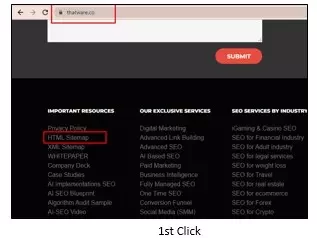
1st Click
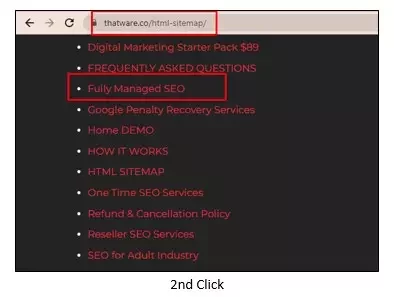
2nd Click
You can see how an HTML Sitemap page consisting of all url links on the website drastically reduces the crawl depth for all pages. Hence creating an HTML Sitemap is crucial for modern-day SEOs.
Here’s a link to Thatware’s HTML Sitemap.
👉Optimising for Voice Search using MREID
Ever since Google has shifted from identifying queries in the “context of keywords” to the “context of object and entities”.
Let us have a quick overview of entities and strings.
Let us take an example of a man’s name like “Jason Barnard”. As a search query, Google’s previous algorithm will consider it a collection of characters or rather as keywords and will show up the most relevant documents pertaining to that keyword based on certain authority signals like links to it.
With the advent of Hummingbird, Google now moves on to consider “Jason Barnard” as an entity itself with an entity ID = /g/11cm_q3wqr, which is the Machine Readable Entity or MREID of this guy:
Understanding various real-time objects in terms of entities by assigning them separated entities help Google to determine semantic relationships between different entities in a document thereby understanding the context of each and every document.
This also works for search as by understanding the semantic relationships between different entities, Google can use the entities in a query to understand its intent and show the most relevant document that satisfies that specific intent instead of the keyword.
Hence optimising for search became more about intent rather than just keywords.
👉How to get MREIDs of an Entity?
An entity is an object either real or abstract for which Google generates separate search engine features which can define the entity fully. It can be a product, a person or a company.
For example, Google understands Thatware by its entity id = “/g/11f653w0qd”.
This can be found by typing Thatware in Google, going to the Google My Business Listing and right-clicking to view the source code.
By searching for “/g/” using Ctrl + F we can find the MREID of that keyword.
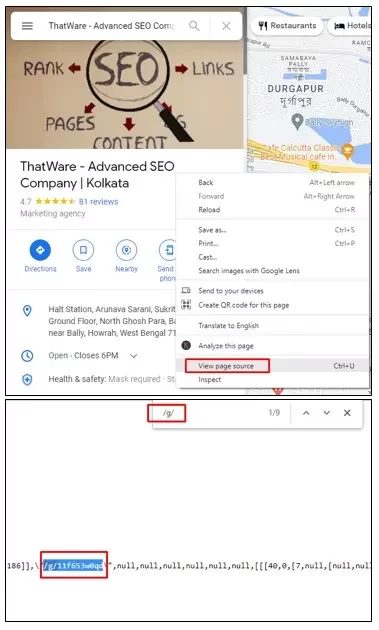
It can also be found using Google Trends such as for Macbook Air, we can get the MREID from Google Trends
Type Macbook in Google Trends and select the product
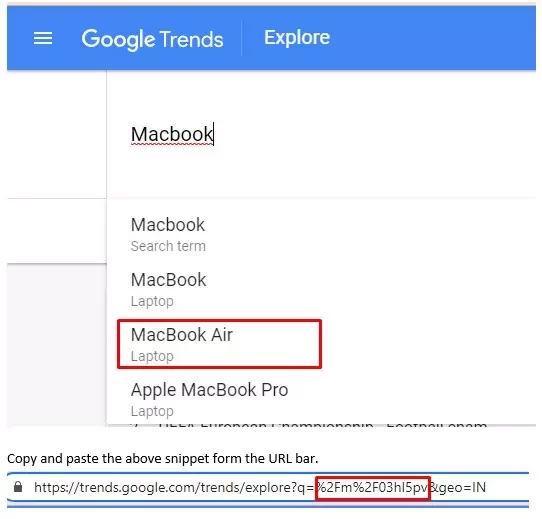
Copy and paste the above snippet from the URL bar.
%2Fm%2F03hl5pv
Now replace the “%2F” with forwarding slashes as /m/03hl5pv.
Hence we get the MREID for Macbook Air.
Another Way to find MREID is by inspecting the knowledge panel for an Entity. For example, for an instrument “Keystar” the MREID is found within the card_id of the page source.
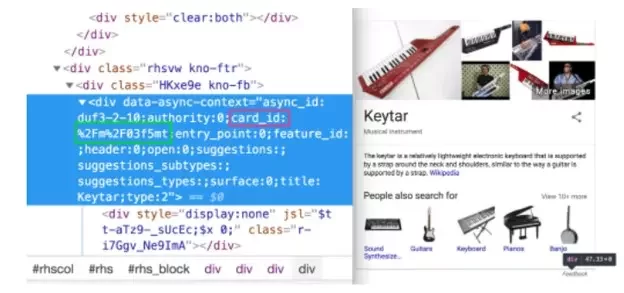
👉How to Implement MREIDs with Schema Codes?
Google algorithm’s job is to gather as much information as possible about a document to enable Google to best serve the document to relevant search queries. There is no better way to provide such information than through Schema Codes.
Even better so if we can feed MREIDs to Google along with the rest information. Here are three ways to feed MREIDs with different schema codes.
👉Inject into Product Review Schema
We can provide MREID Schema into the product review schema by simply adding in the “SameAs” block.
For example, for a product called Apple Macbook Air, we can add it to the Product Schema.
All we have to do now is to prepend a Google Search URL and query with the MREID and kponly (to only show the knowledge graph) attached and add those URLs as sameAs properties to your schema.
<script type=”application/ld+json”>
{
“@context”:”https://schema.org/”,
“@type”:”Product”,
“brand”:{
“@type”:”Brand”,
“name”:”Apple”,
“sameAs”:[ “https://www.apple.com/”, “https://www.google.com/search?q=Apple&kponly&kgmid=/m/0k8z”,]
},
“name”:”MacBook Air M1″,
“sku”:”macbook-air-m1″,
“gtin8″:”macbook-air-m1”,
“image”:”https://myaffiliatesite.com/images/macbook-air-m1.jpg”,
“url”:”https://myaffiliatesite.com/macbook-air-m1-review/”,
“description”:”This MacBook Air M1 review puts Apple’s latest MacBook to the test.”,
“sameAs”:[
“https://www.apple.com/macbook-air/”, “https://www.google.com/search?q=MacBook+Air&kponly&kgmid=/m/03hl5pv”,
],
“review”:{
“@type”:”Review”,
“datePublished”:”2021-05-26″,
“url”:”https://myaffiliatesite.com/macbook-air-m1-review/”,
“inLanguage”:”en-US”,
“description”:”This MacBook Air M1 review puts Apple’s latest MacBook to the test.”,
“publisher”:{
“@type”:”Organization”,
“name”:”MyAffiliateSite”,
“url”:”https://myaffiliatesite.com/”,
“logo”:{
“@type”:”ImageObject”,
“url”:”https://myaffiliatesite.com/images/logo.png”
}
},
“reviewRating”:{
“@type”:”Rating”,
“ratingValue”:”4.5″,
“bestRating”:”5″,
“worstRating”:”0″
},
“author”:{
“@type”:”Person”,
“name”:”Joe Doe”,
“sameAs”:”https://myaffiliatesite.com/author/joe-doe/”
}
}
}
</script>
We also know that Google often references Wikipedia to generate knowledge graphs. So we can add that reference too.
<script type=”application/ld+json”>
{
“@context”:”https://schema.org/”,
“@type”:”Product”,
“brand”:{
“@type”:”Brand”,
“name”:”Apple”,
“sameAs”:[ “https://www.apple.com/”, “https://www.google.com/search?q=Apple&kponly&kgmid=/m/0k8z”, “https://en.wikipedia.org/wiki/Apple_Inc.” ]
},
“name”:”MacBook Air M1″,
“sku”:”macbook-air-m1″,
“gtin8″:”macbook-air-m1”,
“image”:”https://myaffiliatesite.com/images/macbook-air-m1.jpg”,
“url”:”https://myaffiliatesite.com/macbook-air-m1-review/”,
“description”:”This MacBook Air M1 review puts Apple’s latest MacBook to the test.”,
“sameAs”:[
“https://www.apple.com/macbook-air/”, “https://www.google.com/search?q=MacBook+Air&kponly&kgmid=/m/03hl5pv”, “https://en.wikipedia.org/wiki/MacBook_Air”
],
“review”:{
“@type”:”Review”,
“datePublished”:”2021-05-26″,
“url”:”https://myaffiliatesite.com/macbook-air-m1-review/”,
“inLanguage”:”en-US”,
“description”:”This MacBook Air M1 review puts Apple’s latest MacBook to the test.”,
“publisher”:{
“@type”:”Organization”,
“name”:”MyAffiliateSite”,
“url”:”https://myaffiliatesite.com/”,
“logo”:{
“@type”:”ImageObject”,
“url”:”https://myaffiliatesite.com/images/logo.png”
}
},
“reviewRating”:{
“@type”:”Rating”,
“ratingValue”:”4.5″,
“bestRating”:”5″,
“worstRating”:”0″
},
“author”:{
“@type”:”Person”,
“name”:”Joe Doe”,
“sameAs”:”https://myaffiliatesite.com/author/joe-doe/”
}
}
}
</script>
👉Implementing MREIDs in Local Business Schema.
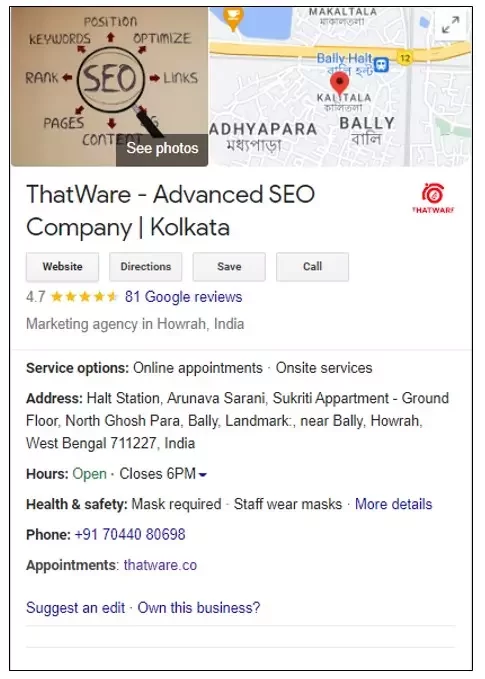
For a Business called Insta Global Travel, we can inject the MREID into the Local Business Schema as follows.
<script type=”application/ld+json”>
{
“@context”: “http://schema.org”,
“@type”: “LocalBusiness”,
“@id”: “http://g.co/kg/g/11f653w0qd”,
“image”:”https://lh5.googleusercontent.com/p/AF1QipM8e6SYYY2Oa9IaYeF4rz9iWuaare9oOtFWJwv7=w408-h333-k-no”,
“address”: {
“@type”: “PostalAddress”,
“addressLocality”: “Halt Station, Arunava Sarani, Sukriti Appartment – Ground Floor, North Ghosh Para, Bally, Landmark:, near Bally, Howrah, West Bengal 711227, India”,
“addressRegion”: “IND”
},
“mainEntityOfPage”: “https://www.google.com/maps?cid=6324742204996025982”,
“description”: “ThatWare LLP is a group of smart digital marketing professionals who are excellent at handling advanced IT solutions and high tech digital marketing goals. Based out of Kolkata, ThatWare LLP has experience in several digital marketing services such as SEM, SEO, ORM, CRO, Schema, Penalty Recovery, SMO, SMM and much more.
Professionals at ThatWare LLP have several years of expertise in managed IT solutions, outsourcing, technical consultancy and much more.
One of the core areas in which ThatWare LLP is expertise is advanced online marketing strategies and improving the business’s sales funnel.
We claim to provide state of the art SEO services making us one of the best SEO agencies in Kolkata.”,
“name”: “ThatWare”,
“telephone”: “+917044080698”,
“email”:”info@thatware.co”,
“priceRange”: “$$”,
“hasMap”: “https://g.page/thatware?share”,
“geo”: {
“@type”: “GeoCoordinates”,
“latitude”: “22.6513316”,
“longitude”: “88.3349138”
},
“areaServed”: {
“@type”: “State”,
“name”: “West Bengal”,
“url”: “https://en.wikipedia.org/wiki/West_Bengal”
},
“sameAs” : [
“https://www.google.com/search?q=thatware&kponly&kgmid=/g/11f653w0qd”,
“https://www.facebook.com/thatware.co”,
“https://twitter.com/thatware”,
“https://in.linkedin.com/company/thatware-llp”,
“https://www.youtube.com/TuhinBanika2z/videos”,
“https://www.instagram.com/thatware.co/”
],
“currenciesAccepted”: “DU”,
“paymentAccepted”: [
“Cash”,
“Check”,
“Invoice”,
“Visa”,
“MasterCard”,
“American Express”,
“Discover”,
“Insurance”
]
}
</script>
This way we can inject MREIDs into different Schema formats.
👉Optimising for Google Rankbrain AI using Rankbrain Schema
With Rankbrain rolling Google made significant advances in its algorithm. With hummingbird, Google was able to understand the existence of entities as opposed to real-world objects. Rankbrain gave Google the ability to find meaning and extrapolate various intents by looking at the entities of a document as a whole.
In its most basic interpretation, Rankbrain’s job is to furnish Google with enough information about the documents in its index to enable it to show those documents which are contextually relevant to the intent of the search query.
So basically to implement Rankbrain Schema is to simply compile all types of Schema Information that we can furnish for a specific document. Here’s one example for
<script type=”application/ld+json”>
{
“@context”: “http://schema.org”,
“@type”: “WebPage”,
“breadcrumb”: “Home > Blog > High Performance Sport Sunglasses Guide”, //Breadcrumb
“mainEntity”:{
“@type”: “Article”,
“name”: “High Performance Sport Sunglasses Guide”,
“headline”: “High Performance Sport Sunglasses Guide”,
“author”: “Heavyglare Eyewear”,
“image”: “https://shop.heavyglare.com/blog/wp-content/uploads/2017/10/High-Performance-Sport-Sunglasses-Guide.jpg”,
“inLanguage”: “English”,
“publisher”: {
“@type”: “Organization”,
“name”: “High Performance Sport Sunglasses Guide”,
“logo”: {
“@type”: “ImageObject”,
“name”:”Heavyglare Eyewear Logo”,
“height”:”50″,
“width”:”200″,
“url”: “https://shop.heavyglare.com/media/wysiwyg/logo.png”
}
},
“datePublished”: “2018-5-12”,
“dateModified”:”2018-5-14″,
“mainEntityOfPage”: {
“@type”: “WebPage”,
“@id”: “https://shop.heavyglare.com/blog”
}
}
}
</script>
<script type=”application/ld+json”>
{
“@context”: “http://schema.org”,
“@type”: “BlogPosting “,
“publishingPrinciples”:{
“@type”:”Table”, //Contents
“name”:”Contents”,
“sameAs”:[“1.Functionality of your lenses is imperative”, “2.Quality lens materials make a difference”,”3.High performance sport sunglasses need to fit properly”]
},
“headline”: “High Performance Sport Sunglasses Guide”,
“author”: {
“@type”: “Person”,
“name”: “Heavyglare Eyewear”
},
“image”: [
“https://shop.heavyglare.com/blog/wp-content/uploads/2017/10/High-Performance-Sport-Sunglasses-Guide.jpg”
],
“publisher”: {
“@type”: “Organization”,
“name”: “Heavyglare Eyewear”,
“logo”: {
“@type”: “ImageObject”,
“name”:”Heavyglare Eyewear Logo”,
“height”:”50″,
“width”:”200″,
“url”: “https://shop.heavyglare.com/media/wysiwyg/logo.png”
}
},
“datePublished”:”2018-5-12″,
“dateModified”:”2018-5-14″,
“mainEntityOfPage”: {
“@type”: “WebPage”,
“@id”: “https://shop.heavyglare.com/blog”
},
“keywords”:”lens,sunglass lens characteristics,sunglass lenses,sunglass lens issues”,
“wordCount”:”1800″, //wordcount
“mainEntity”:{ //Anchortext
“@type”:”brand”,
“name”:[“shop.heavyglare.com”,
“heavyglare eyewear”,
“heavyglare”,
“sports eyewear”,
“prescription sunglasses”,
“heavyglare.com”
]
},
“workExample”:{ //Quora questions
“@type”: “Question”,
“text”: “What is the colour of sky?”,
“dateCreated”: “2018-5-12”,
“author”: {
“@type”: “Person”,
“name”: “A”
},
“acceptedAnswer”: {
“@type”: “Answer”,
“text”: “blue”,
“dateCreated”: “2018-5-14”,
“author”: {
“@type”: “Person”,
“name”: “A”
}
},
“mainEntity”:{ //loop
“@type”:”HowToStep”,
“name”:”suggested answers”,
“itemListOrder”: “http://schema.org/ItemListOrderAscending”,
“itemListElement”:[
{
“@type”: “Answer”,
“position”: “1”,
“text”: “black”,
“dateCreated”: “2018-5-14”,
“author”: {
“@type”: “Person”,
“name”: “B”
}
},
{
“@type”: “Answer”,
“position”: “2”,
“text”: “red”,
“dateCreated”: “2018-5-14”,
“author”: {
“@type”: “Person”,
“name”: “B”
}
}
]
}
},
“potentialAction”:{ //questions with loop
“@type”: “AskAction”,
“agent”: {
“@type”: “Person”,
“name”: “John”
},
“recipient”: {
“@type”: “Person”,
“name”: “Steve”
},
“object”:{
“@type”:”HowToStep”,
“name”:”Queries”,
“itemListOrder”: “http://schema.org/ItemListOrderAscending”,
“itemListElement”:[
{
“@type”: “Question”,
“position”: “1”,
“text”: “What’s 2 + 2?”
},
{
“@type”: “Question”,
“position”: “2”,
“text”: “What’s 21 + 22?”
}
]
}
},
“exampleOfWork”:{ //how to
“@type”:”HowTo”,
“name”:”How to choose a good sunglass for better performance?”,
“url”:”https://shop.heavyglare.com/blog/high-performance-sport-sunglasses-guide/”,
“description”:”Read the article to know the process of choosing a good sunglass”,
“image”:”https://shop.heavyglare.com/blog/wp-content/uploads/2017/10/High-Performance-Sport-Sunglasses-Guide.jpg”,
“inLanguage”:”en-US”,
“keywords”:”lens,sunglass lens characteristics,sunglass lenses,sunglass lens issues”,
“steps”:{
“@type”:”HowToStep”,
“name”:”Queries”,
“itemListOrder”: “http://schema.org/ItemListOrderAscending”,
“itemListElement”:[
{
“@type”: “HowToDirection”,
“position”: “1”,
“name”:”Aim to protect your eyes first and foremost.”,
“description”:”Excessive exposure to UV radiation can cause a variety of problems for your eyes such as cataracts, burns, and cancer.”
},
{
“@type”: “HowToDirection”,
“position”: “2”,
“name”:”If you want your sunglasses to protect you from these risks, look for pairs that block at least 99% of UVB rays and at least 95% of UVA rays.”,
“description”:”Also look for the amount of cover the sunglasses provide. Look at how much you can see around the frames––will the sunglasses let in sun from the top or sides?”
},
{
“@type”: “HowToDirection”,
“position”: “3”,
“name”:”Don’t buy sunglasses if they’re labeled as ‘cosmetic’ or don’t provide any information on UV protection.”,
“description”:”Look for scratch resistance, many lenses have very fragile coatings. If you are spending much money, you want them to last. Fortunately damaged lenses can be replaced for most models.”
},
{
“@type”: “HowToDirection”,
“position”: “4”,
“name”:”Choose scratch-resistant lenses.”,
“description”:”Scratched up sunglasses are useless sunglasses. Lenses made from NXT polyurethane are impact-resistant, flexible, lightweight, and have great optical clarity, but they’re expensive.”
},
{
“@type”: “HowToDirection”,
“position”: “5”,
“name”:”Check for distortion.”,
“description”:”Hold the lenses up to a fluorescent lamp. As you move the sunglasses up and down, check that wave distortion doesn’t happen. If it doesn’t happen, this is a good sign.”
}
]
}
},
“video”: { //video
“@type”: “VideoObject”,
“description”: “Get a visual idea about the high performance sport sunglasses.”,
“uploadDate”:”2018-05-14″,
“duration”: “T1M33S”,
“name”: “High Performance Sport Sunglasses Guide”,
“thumbnail”: “High-Performance-Sport-Sunglasses-Guide.jpg”,
“thumbnailUrl”:”https://shop.heavyglare.com/blog/wp-content/uploads/2017/10/High-Performance-Sport-Sunglasses-Guide.jpg”
},
“encoding”:{ //infographic
“@type”: “ImageObject”,
“name”: “Infographic on High Performance Sport Sunglasses Guide”,
“author”: “Heavyglare Eyewear”,
“contentUrl”: “https://shop.heavyglare.com/blog/wp-content/uploads/2017/10/High-Performance-Sport-Sunglasses-Guide.jpg”,
“datePublished”: “20018-05-12”,
“description”: “Get a visual idea about the high performance sport sunglasses.”
}
}
}
</script>
The main part in the entire above schema is shown below “How to section”
“object”:{
“@type”:”HowToStep”,
“name”:”Queries”,
“itemListOrder”: “http://schema.org/ItemListOrderAscending”,
“itemListElement”:[
{
“@type”: “Question”,
“position”: “1”,
“text”: “What’s 2 + 2?”
},
{
“@type”: “Question”,
“position”: “2”,
“text”: “What’s 21 + 22?”
}
]
}
},
“exampleOfWork”:{ //how to
“@type”:”HowTo”,
“name”:”How to choose a good sunglass for better performance?”,
“url”:”https://shop.heavyglare.com/blog/high-performance-sport-sunglasses-guide/”,
“description”:”Read the article to know the process of choosing a good sunglass”,
“image”:”https://shop.heavyglare.com/blog/wp-content/uploads/2017/10/High-Performance-Sport-Sunglasses-Guide.jpg”,
“inLanguage”:”en-US”,
“keywords”:”lens,sunglass lens characteristics,sunglass lenses,sunglass lens issues”,
“steps”:{
“@type”:”HowToStep”,
“name”:”Queries”,
“itemListOrder”: “http://schema.org/ItemListOrderAscending”,
“itemListElement”:[
{
“@type”: “HowToDirection”,
“position”: “1”,
“name”:”Aim to protect your eyes first and foremost.”,
“description”:”Excessive exposure to UV radiation can cause a variety of problems for your eyes such as cataracts, burns, and cancer.”
},
{
“@type”: “HowToDirection”,
“position”: “2”,
“name”: “If you want your sunglasses to protect you from these risks, look for pairs that block at least 99% of UVB rays and at least 95% of UVA rays.”,
This set of different schemas gives all possible information about the blog “High Performance Sport Sunglasses Guide” which can be picked up by the Rankbrain algorithm and can massively boost ranking and traffic generated for that website page.
👉Optimizing for Voice Search using Passage Indexing
Sometimes people are looking for specific answers to a very specific search query. For example: for those of you wondering “What is passage indexing”.
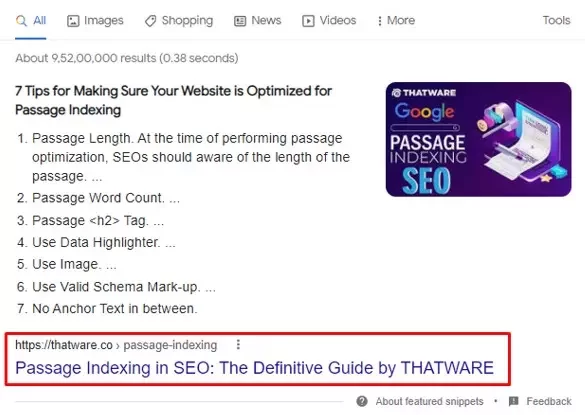
This is a new kind of search feature which allows Google to answer oneliner queries such as above.
Google Martin Splitt was excited when he announced the breakthrough of Google where they can now not only index web pages but also can index individual passages in content.
This allows Google to answer very specific search queries by simply showing the most relevant passage above all serp results. Thus satisfying the searcher’s intent to gain a quick answer.
👉How to Optimise for Passage Ranking
We at Thatware have tried with several contents and tried to optimise our pages for passage ranking.
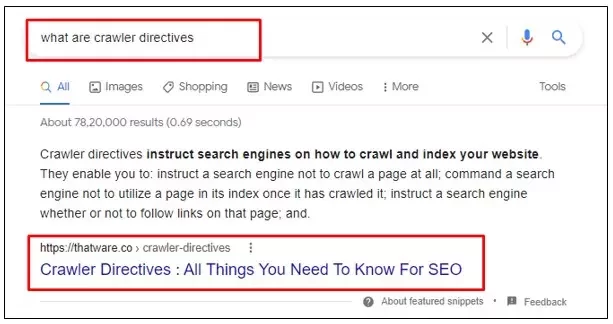
After several experiments, our passages rank for several search terms as above.
Here are our observations regarding how to optimise passage indexing.
1. PASSAGE LENGTH
Let us assume that a particular page has 3000 words worth of content. We organize passages intended for passage ranking not more than 1% or 2% of the total word count. This means each passage should have 30-60 words at most. In other words, passage segregation should be around 1-2% of the intended word count. Such a passage is ideal to serve as an answer to specific queries.
2. PASSAGE <H2> TAG
If a passage consists of a <H2> tag then it should have an LSI keyword in the tag. In other words, if a passage is followed by any h-tag then it’s recommended to use an LSI keyword within the H-tag whether it be <h1> or H2> or etc.
3. USE DATA HIGHLIGHTER
If you are optimising a certain passage from the content then you have to use data highlighter with the help of Google Search Console’s Data Highlighter tool. The option varies in the list from site to site, suppose you are optimising a passage for an article based website, then you have to choose an article from the given list in GSC.
You can check out more about Passage Indexing below:
5. USE IMAGE
It is recommended that you use at least one image for the particular page that you are optimizing for passage indexing. And it should be placed below a passage. For reference, please see the attached layout by end of this article!
6. USE VALID SCHEMA MARK-UP
It is recommended that you use the specific passage into the schema code for which you are optimizing the page. It’s advised to use JSON-LD for the markup!
7. NO ANCHOR TEXT IN BETWEEN
The passage should not contain anchors but there should be internal and external hyperlinks above or below. Well, there is no such rule still it’s our practical experience that having no anchors within the passage helps with the optimization. Moreover, having an internal link / external link above or beyond also helps with the process.
Wrapping up this section you can learn more about Passage Indexing and its benefits here.
Semantic Topic Clustering
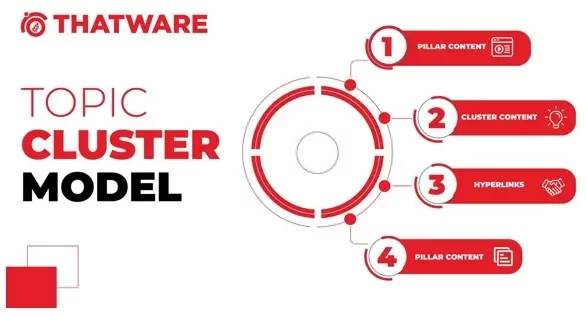
https://thatware.co/passage-indexing/
Why does Topic Cluster Model Work
This is more to do with the fact that Google no longer ranks Websites based on Keywords but on search intent. Instead, it determines whether a particular website has enough authority or credibility to cover a topic in its entirety.
In order to explain Topic clusters, let’s take a simple example. Let us consider the keyword “Legal services” with search volume (9600/month) which we want to target. We can create an entire Landing Page dedicated to different aspects of Legal Services that our organisation may provide. This will be our main topic or pillar page.
Under the pillar page clusters of content will be created each targeting more specific but relevant keywords such as:
- Pro-bono legal services (1500 searches/month)
- commercial property lawyer (1400 searches/month)
- Community legal services (3300 searches/month)
- Legal aid services (2200 searches/month)
- Immigration Legal Services (600 searches/month)
Etc…
Hubspot takes it a step further. For example, the “community legal services” itself has enough search volume to be considered a topic. This can be broken up into further content like
- eastside legal assistance program
- northern community legal service
- neighbourhood legal services
- Latino legal services
- LGBTQ legal aid
- Suncoast community legal services
Hence you can see how easy clusters themselves can form their own topic cluster, thus making the entire structure a Tier 2 topical cluster.
Since the clusters serve specific long-tail variations of keywords they not only help in increasing the number of keyword rankings but also serve to answer each individual question and aspect related to the broader topic of “legal services”
These cluster contents start gathering traffic from Google searches and gain ranking. As these ranked pages link to the main pillar page optimised for the Keyword Legal services, Google understands that page as an authority on the topic as it gains links from a number of ranking pages. Hence eventually the Pillar page starts ranking for the keyword “Legal services” as well
👉Tools to find Cluster Keywords.
Soovle – Soovle is a great tool to find Longtail and semantic variations of any Keyword. It is a tool that shares auto-suggestions and commonly used keywords based on your query from 6 different search engines, namely Wikipedia, Amazon.com, Answers, Youtube, Bing, and Yahoo.
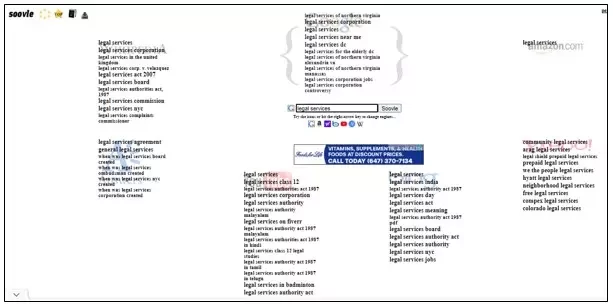
👉Bag of Words
Bag of word is an excellent tool to generate keyword ideas that are leveraged by our competitors but not by us. It is an information retrieval model which extracts keywords using large amounts of data and also mentions the frequency of those keywords in the document. In SEO we use to create a cloud of Keywords with different weightage based on their popularity and also compare it with competitor’s cloud to make meaningful keyword suggestions.
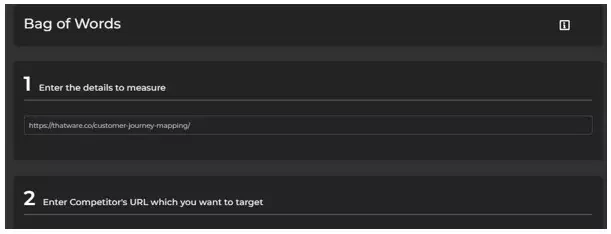
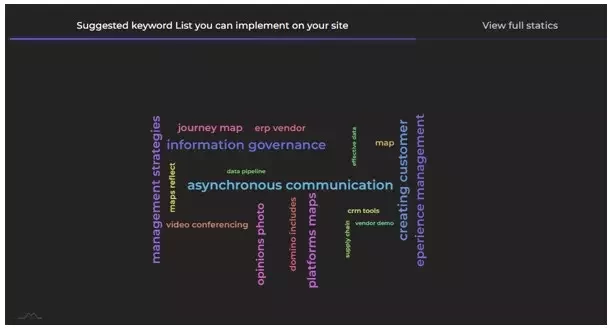
These keywords are arranged and their size determines their weightage. These can be used as excellent cluster topics.
👉Use LSI Graph Tool to generate LSI Keywords
LSI Keywords are keywords which are semantically linked to a target keyword or a query. We must optimise a document with not only a focus keyword but also LSI variations that clearly define the intent that the document satisfies.
These help Google to have a thorough understanding of the context of web content. Not only that these are also excellent cluster content ideas as the main purpose of a topic-cluster model is to create cluster content on low difficulty keywords which are semantically related to the main pillar keyword or keyphrase.
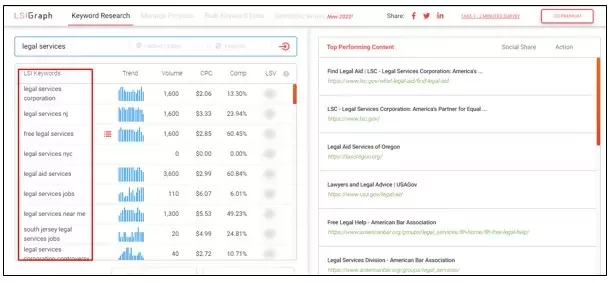
👉FAQ Schema is a MUST!
Have you ever wondered what is the most common way users search in Google? They ask questions! Hence as SEOs, it is imperative that we include an FAQ section at the end of our service and blog pages and optimize it to include answers to the most common question around a topic.
A FAQ Page or a section consists of a list of questions and relevant answers around a particular topic. When such pages are properly marked up these questions can be shown as rich snippet results in Google SERP. It looks something like this:
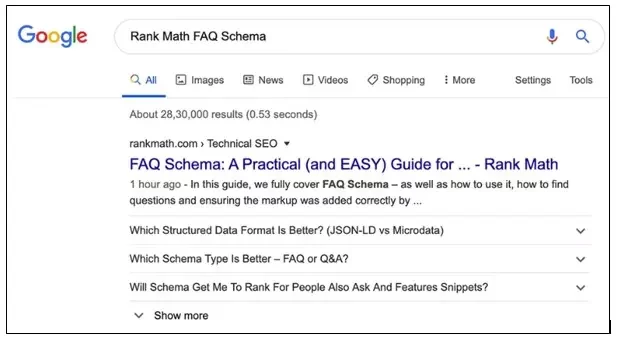
👉SEO Benefits of FAQ Schema and Rich Snippet
- Increase in SERP Visibility: FAQ schema adds more content to your SERP listing thereby increasing the size and hence the clickthrough rate of your website. Also, the user is able to skip to any relevant question that he might find useful through FAQ Schema.
- Optimising for Voice Search: FAQ Schema also helps us to optimise for voice search as it helps you to directly feed info for an action which is inbuilt in Google Digital Assistant. This helps our content to become a source for a lot of questions for which content can be directly fed into the Google assistant results.
👉How to Implement FAQ Schema
The best and simplest way to implement FAQ Schema is using a schema markup generator and to use a plugin in WordPress to implement the code in header and body sections. For example, HFCM is a good plugin to manage such insertions.
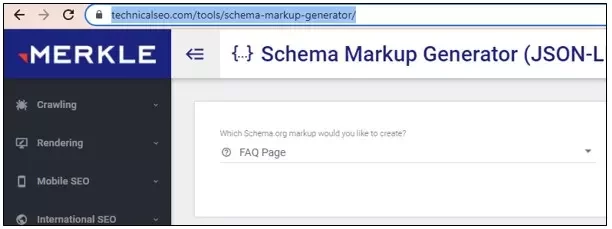
- Select FAQ Page in the Schema Categories
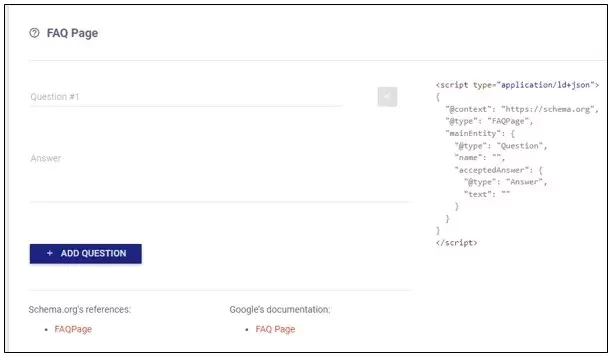
- Write the Questions one by one along with the intended answers and the Schema will be generated alongside. You can copy the code once done and inject into the Header or Body tags.
👉Using Topic Relevant Quotes using Quotes HTML
Quoting content from an external source generally doesn’t hurt SEO. Instead quotes help in adding value to your content.
An SEO friendly way to do this is using the inline quotation tag <q>.
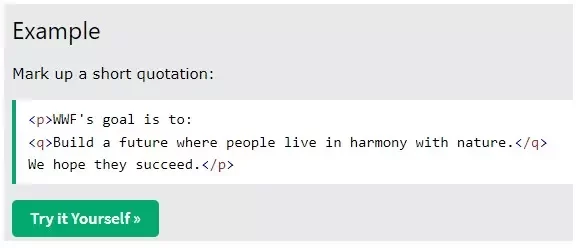
This is the right way to tell Google that we are quoting content from an external source with a 90% chance of no SEO drawback.
👉N-Gram
N-Gram is a measurement process which is used to determine the weightage of Keywords in a document. It basically tells us how many times a sequence of n words is repeated in our list.
A 1 gram word is just a word like “life”, “tie” etc.
A keyphrase of 2 words is a 2-gram keyword
And so on…
It is usually used to optimize content around some focused keyword for a document with hundreds and thousands of potential keywords.
👉How does it Work?
Using an N-Gram analysis tool is simple.
- First, we enter the url of the document which we want to optimise.
- Add two or three competing URLs.
- The algorithm analyses and find the most used Keywords not only in our document but also the most weighted words on the competitor’s pages.
- On the basis of this analysis, the tool then provides keyword suggestions based on Weightage which the document can be optimised for.
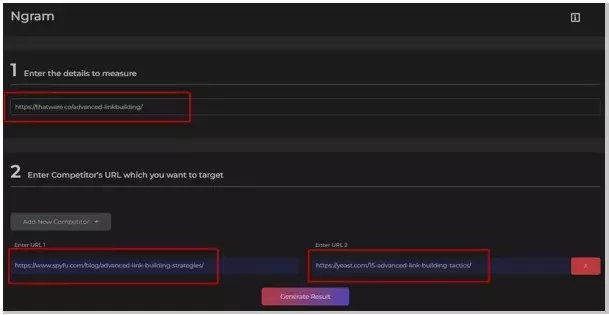
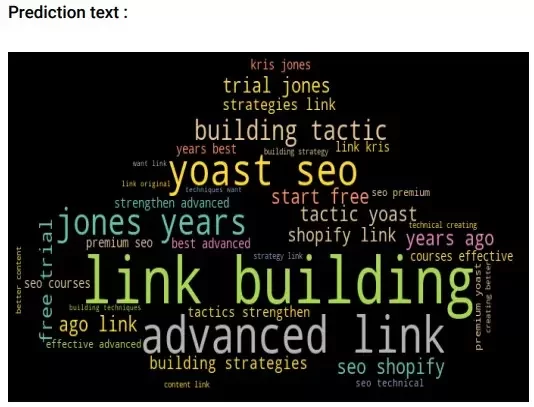
👉TF – IDF Measurement
What is TF-IDF?
Let’s learn about TF or Term Frequency. As the name suggests it is a measure of the number of times a particular keyword occurs in a document.
TF = (No. of times a keyword appears in a document) / (Total Number of Words)
DF Score or document frequency = (Number of docs) / (Total Number of documents where the keyword appears in a Database)
IDF = log(DF)
When TF is multiplied by the IDF, then the resulting score is lower for commonly used words and higher for niche-specific or intent specific topics.
When we use Keywords that have a high TF-IDF scores, those words indicate to Google the context of the page more than regular words.
👉Benefits of TF-IDF Optimization
First, to clear it our, TF-IDF is not a ranking signal. But what Google cares about is Semantic search.
For example, let us be a search engine that does not know the meaning of Trout. Let us analyse the following sentences.
- Trout is rich in omega-3 fatty acids.
- Trout has tender flesh and a mild, somewhat nutty flavour.
- When choosing trout we pay attention to a clear red-orange colour.
Also, let us assume we understand what a Salmon is. That when we encounter the following lines,
- Salmon is a popular type of fish in Western cuisine, which goes well with white wine.
- Tender salmon meat can be added to pasta.
- Salmon skin is super nutrient-dense, so keep it why you cook.
The mere occurrence of the word Trout with words like “Omega 3, flesh, salmon, pasta” gives us an idea that Trout might be some type of edible fish.
These are called Co-occurrence words. Google uses co-occurrences to determine semantic relationships between various words for a long time. This is exactly where TF-IDF comes to play.
Using a TF-IDF tool we can find various such Co-Occurrence suggestions based on their high TF-IDF score. This way we can optimise our content with such co-occurrences, hence making sure Google interprets the context of the document correctly and more specifically increase the weightage of some keywords as we desire.
👉How to Use a TF-IDF Tool
- First, we enter the document URL we want to optimise.
- Then we enter 2-3 competitor URLs which are relevant and ranking for our target keywords.
- The tool will analyse the TF-IDF value of various words and identify those with high Tf-IDF Scores.
- It will show a chart of words weighed according to their TF-IDF value for each URL along with competitors.
- At last, it will suggest possible keywords which are not currently in our document that we can implement to make sure our document is optimised for all relevant co-occurrences.
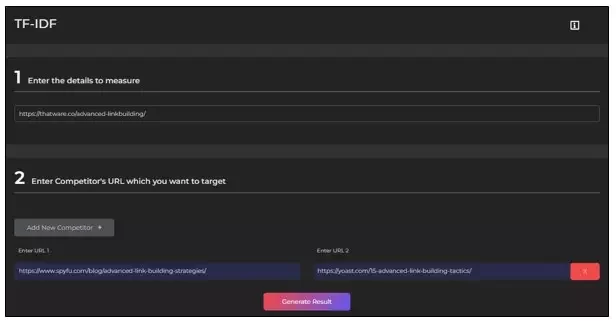
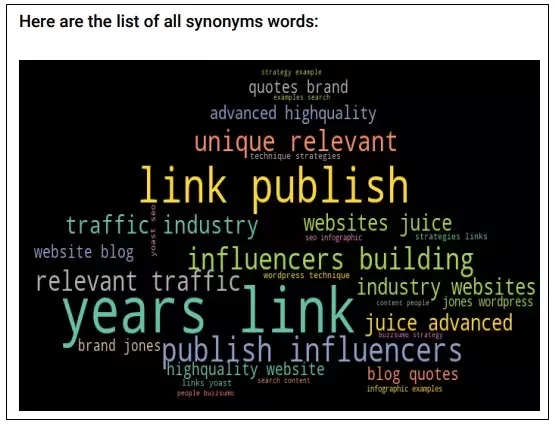
👉Capitalising on Phrase-based Indexing by Leveraging Co-Occurring Words
This section is based on the same idea of Co-occurrence that we determined using the TF-IDF technique. Search engines like Google process millions of documents and search queries every minute. Hence it is not just able to index pages and keywords, but individual phrases too.
Hence it has the ability to predict that certain phrases occur with certain co-occurring phrases more often. Through the presence of these Co-occurring phrases together in a document, Google gets a better idea about the topic of focus for that particular document.
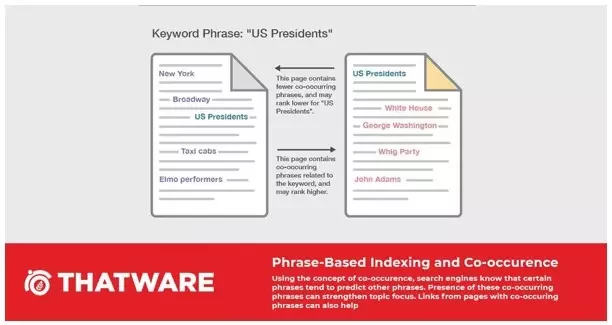
Hence if a tool gives us a set of all relevant co-occurring words around our target keyword, then all we have to do is to optimise our document with the relevant suggestions, hence we can indicate the context of the document more strongly and improve its SERP visibility for the intended set of queries.
👉Using a Co-occurrence Suggestion Tool to Optimise for Phrase Indexing
- First, we enter the document URL we want to optimise.
- Then we enter the target keyword.
- The Tool returns a set of co-occurring keywords commonly appearing for the target keyphrase on the internet.
- Optimising our document for these words will help us improve the SERP visibility of the page for the intended target keyphrase and relevant variations.
👉Topic Modelling with LDA Algorithm
Topic Modelling is the process of identifying distinct Topics or Words with topical significance in a group of text. It is essentially useful in the context of topic clustering. Despite several techniques that help us do this, most data scientists prefer the LDA method.
“LDA assumes documents are produced from a mixture of topics. Those topics then generate words based on their probability distribution. Given a dataset of documents, LDA backtracks and tries to figure out what topics would create those documents in the first place.”
Let’s visualise how the algorithm is able to identify this in real time. We ran an analysis on a set of SERP data for the keyword “yoga for beginners”.
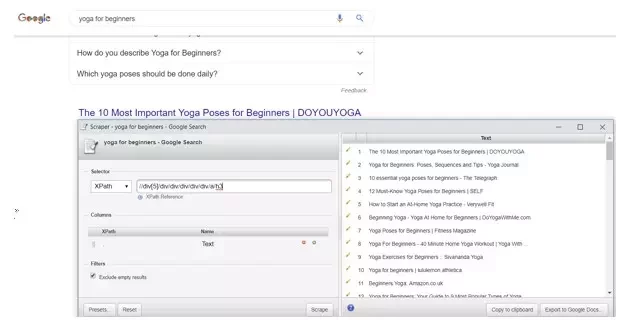
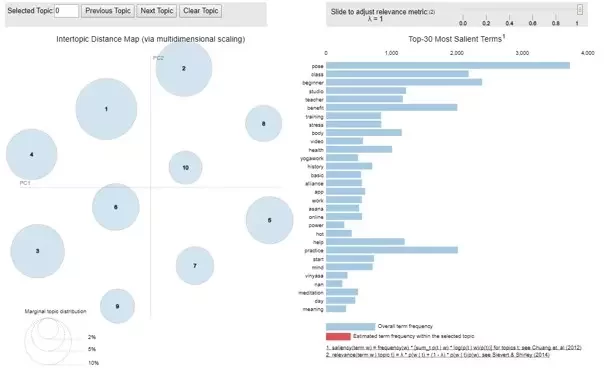
We visualized the output using the PyLDAvis package.
The left-hand side shows all the major identified topics covered in the document. If you are interested you can check how the visualisation works here. Basically the further away these topics are the more distinct it is. The right-hand side contains words that create these topics.
This is very interesting as, at a glance, we can understand what search topics is Google most interested in. It can also be used to make content recommendations all over the website and create long term content and topic model around which we can centre our content marketing strategies.
If this tool can give us so many content suggestions, imagine how much more efficient Google is in identifying topics and content hubs. Using the LDA algorithm to find content and topic suggestions can greatly enable us to find and optimise our pages on the basis of on-demand searchable content.
👉How do you know your Topic Modelling is Wrong?
Another Note to check is whatever we do, make sure our Web pages don’t look like this:
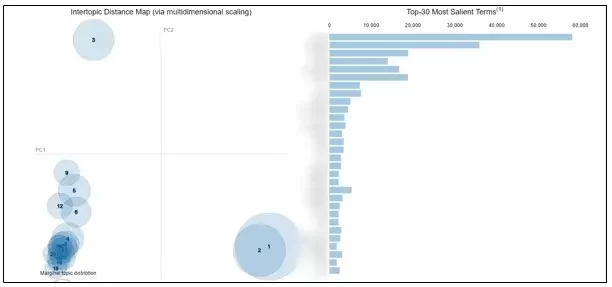
This excessive overlapping shows that the topics are not distinct enough, hence our original search term might not have enough semantically related but distinct subtopics.
👉Keeping Passages Unique using SMITH Algorithm Tool
Google recently published a research paper based on a new Algorithm that it claims, outperforms BERT. It stands for Siamese Multi-depth Transformer-based Hierarchical Encoder.
In a very basic sense, while BERT is able to understand the relationship between words and short sentences, the SMITH algorithm can understand and index long queries and passages.
There is no official confirmation of the SMITH rollout as a Google update. However, that does not stop us from assuming that Google doesn’t already use it.
👉How does it Work
The Algorithm is a set of rules that when satisfied increases the chances of it showing up in “passage ranking”. Here’s a basic outline of its working.
- We first take a long content with lots of passages. Probably a landing page of a website
- Then we check passage density in the content.
- Then we check the word count of each passage.
- Check any long-tail keywords if it’s available in the passage or not
- The check similarity distance between two passages.
- Check, If the similarity distance is high, has a long tail keyword available & satisfies the density criteria then the passage fulfils the SMITH algorithm in search engine optimization.
The rules to be satisfied are as follows:
- word count of passage: 30-70
- Long-tail keyword present = greater than 1
- Similarity Should be above 0.5
Below we have taken an example content from https://thatware.co/about-us/
After running this content through a python program that specifically checks the above three criteria and also measures the passage density.
👉Output
P.S: The code triggered 7 passages and whilst counting the word the stop words have been ignored!
- [There are many technical seo companies around the world but THATWARE is recognized as a leader in it.]
- Word count: 9
- Passage Density 4.411764705882353
- [Traditional marketing never provided a better opportunity in understanding the customer’s need. Moreover, with old school marketing, proper analysis and handling of data were a lot difficult. As a result, the ROI and efficiency were much lower as compared to the AI-based marketing model. 4 key benefits are highlighted here as to why seo services should use the ai model over the traditional approach.]
- Word count: 39
- Passage Density 19.11764705882353
- [AI gives a positive influence on SEO. With AI, corporations can boost the precision, efficiency, and performance of search engine optimization techniques, comprising the content generated for SEO. While some SEOs may fear that AI will replace their role, AI fulfils a supporting role as equipment. AI in SEO assists to enhance your recent SEO strategy by finding out chances, like related keywords. Its algorithms, as well as rate, help businesses expedite the method and improve the precision of keyword research, competitor analysis, search intent analysis, and much more.]
- Word count: 59
- Passage Density 28.921568627450984
- [There are many technical seo companies around the world but THATWARE is recognized as a leader in it. From advanced off-page services to professional seo services we are the market leader. ]
- Word count: 18
- Passage Density 8.823529411764707
- [Our main value-added proposition is ai seo optimization & business seo with cutting edge technologies such as data science, machine learning, semantic engineering, advanced search, and much more.]
- Word count: 23
- Passage Density 11.27450980392157
6. [While some of the SEOs may fear that AI will replace their role, AI fulfils a supporting role as an equipment.AI in SEO assists to enhance your recent SEO strategy by finding out chances, like related keywords. Its algorithms, as well as rate, help businesses expedite the method and improve the precision of keyword research, competitor analysis, search intent analysis, and much more. ]
- Word count: 39
- Passage Density 19.11764705882353
- [Its algorithms, as well as rate, help businesses expedite the method and improve the precision of keyword research, competitor analysis, search intent analysis, and much more. ]
- Word count: 17
- Passage Density 8.333333333333332
THE NUMBER OF LONG-TAIL KEYWORDS AVAILABLE IN THE PASSAGES IS AS UNDER:
For Passage 1:
- Number of long-tail keywords present: 6
For Passage 2:
- Number of long-tail keywords present: 14
For Passage 3:
- Number of long-tail keywords present: 6
For Passage 4:
- Number of long-tail keywords present: 7
For Passage 5:
- Number of long-tail keywords present: 5
For Passage 6:
- Number of long-tail keywords present: 3
For Passage 7:
- Number of long-tail keywords present: 2
👉THE SIMILARITY SCORE’S FOR THE PASSAGES HAVE BEEN GIVEN BELOW:
P.S: Every passage has been compared with their subsequent passages for a similarity comparison
For Passage 1:
- In passage 2, Score is 0.243
- With passage 3, Score is 0.214
- In passage 4, Score is 0.8
- With passage 5, Score is 0.172
- With passage 6, Score is 0.218
- With passage 7, Score is 0.162
For Passage 2:
- With passage 3, Score is 0.356
- In passage 4, Score is 0.283
- With passage 5, Score is 0.209
- With passage 6, Score is 0.341
- With passage 7, Score is 0.315
For Passage 3:
- In passage 4, Score is 0.21
- With passage 5, Score is 0.152
- With passage 6, Score is 0.915
- With passage 7, Score is 0.622
For Passage 4:
- With passage 5, Score is 0.197
- In passage 6, Score is 0.206
- In passage 7, Score is 0.159
For Passage 5:
- In passage 6, Score is 0.15
- With passage 7, Score is 0.219
For Passage 6:
- With passage 7, Score is 0.686
👉CONCLUSION AND FINAL RESULT
After checking each passage with our code we can say that only one paragraph follows closely the SMITH algorithm. Here it is:
[While some of the SEOs may fear that AI will replace their role, AI fulfils a supporting role as an equipment.AI in SEO assists to enhance your recent SEO strategy by finding out chances, like related keywords. Its algorithms, as well as rate, help businesses expedite the method and improve the precision of keyword research, competitor analysis, search intent analysis, and much more.]
- Passage similarity Score 0.915
- Number of long-tail keywords present: 3
- Word count: 39 (without stop words)
- Passage Density 19.11764705882353
Only the above passage fulfils all conditions of the SMITH algorithm here. Hence this passage has a higher chance of being used in Google passage ranking.
👉Google MUM Update | Refined Search
MUM or Multitask Unified Model is Google’s approach to answering complex search queries. We all agree that Google is able to surface good results when it comes to topic-based keywords or 3-4 gram queries. But when it comes to complex questions or queries, Google might not be able to share straight or always relevant results.
Let’s understand this with an example. Let’s say a hiker searches “I’ve hiked Mt. Adams and now want to hike Mt. Fuji next fall, what should I do differently to prepare?”
When you check the SERP result for this query? Here’s the result
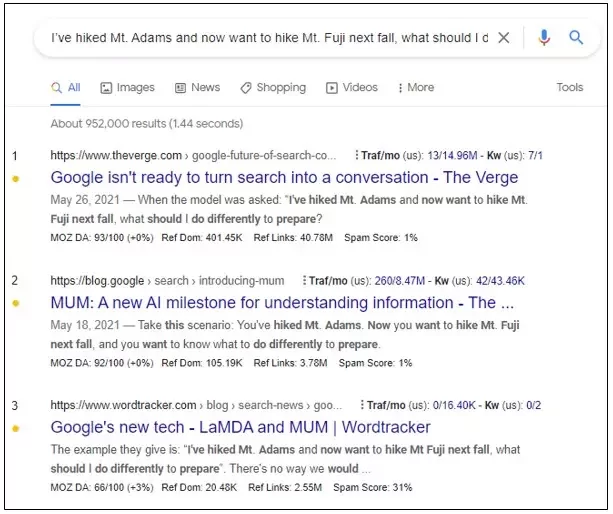
Since MUM has not rolled out yet, you can see that Google is not able to give any definite search result.
MUM is being developed to address just that. MUM not only will try to understand the context of the query better to surface relevant pages to answer the question definitively, but in addition MUM can surface insights based on a deep knowledge of the world, meaning it could point out information like fall is the rainy season on Mt. Fuji so the user might need a waterproof jacket.
“Today’s search engines aren’t quite sophisticated enough to answer the way an expert would. But with a new technology called Multitask Unified Model, or MUM, we’re getting closer to helping you with these types of complex needs. So in the future, you’ll need fewer searches to get things done.”
- Google hangout.
Perhaps the most important aspect of MUM is that it can understand queries across content formats and languages. Hence it is claimed to be better prepared to answer complex queries than BERT could ever do.
“MUM not only understands language, but also generates it. It’s trained across 75 different languages and many different tasks at once, allowing it to develop a more comprehensive understanding of information and world knowledge than previous models.
And MUM is multimodal, so it understands information across text and images and in the future, can expand to more modalities like video and audio.”
- Google hangout
👉How should we Prepare for the MUM Update?
When fully implemented MUM will have a huge impact on the way search results are delivered. That being said it is to be noted that MUM is an opportunity and not a threat. Since MUM is multi-modal and can understand and find context between searches across different formats, it will open much more avenues for content marketing than ever before.
👉Classic SEO will still Rock
Although the considerations over how search results will deliver will change, still you will have to provide all the information to Google that you can about your content. There’s no better way to do that but to keep following Google SEO Webmaster guidelines, and create a schema for different kinds of content. Ultimately the goal is to provide as much information to Google as possible.
👉Local SEO might be a Priority
Since complex searches tend to be local, hence optimizing for MUM would primarily mean optimising for complex and specific searches. Hence Local SEO will be vital to boost your rankings and have a greater chance to get organic visibility not just in Google Maps but in various other formats as well.
👉Create Content-focused around Long-tail Keywords and Specific Queries
With Google preparing itself to answer specific queries with MUM updates, it will now become vital to expand our content marketing efforts. Make sure to create content for all possible and related search queries around your target keyphrase.
Also, it will create content in multiple formats and languages. Since MUM is multi-modal it understands information across text and images and in the future, can expand to more modalities like video and audio.
Hence for specific queries, MUM can surface relevant videos, pictures and even short-form content to not only deliver the best possible answer to the user but also room for deeper exploration that might further satisfy his intent.
All the more reason to stay omnipresent in our content marketing efforts.
👉Leverage Image Search in Google Lens
Users may presently execute a few basic image-based searches with Google Lens, such as finding things for sale online based on a photo of the product. The MUM upgrade will expand these capabilities by allowing users to search for products that have the same pattern, colour, or shape as the reference image, as well as add more image query criteria.
Remember that MUM will remove language as a criterion in search, allowing non-native clients access to foreign marketplaces. Users will be able to search for extremely precise products based on their individual preferences, with more alternatives than ever before. This is an excellent opportunity for e-commerce companies to accommodate the increased demand. Include a lot of high-quality product photos.
Determining Keyword Relevance to Page Content using Cosine Similarity
👉Preface to Word Vectors
Word vectors or word embedding helps to better understand the text as it not only shows the word but helps to determine some context around it. You can learn how vectors can be used to represent real-world concepts here.
Vectors work by mapping the position of each token in different sentences and by calculating the probability of finding a given token in the same position.
As a simple example lets take the query “I would love to hang out with my _______”.
From our perception the blank word would be “friends, family, boyfriend, BFF etc.” However one can expect its most certainly not “pants” or “drills”. Good thing is Google understands it too.

In a multidimensional space, words like boyfriend, BFF, friends would appear much closer rather than words like “pants” and “drills”. Hence clusters of words can be used as vectors and distances can be calculated between them.
Another reason why the vectorized text is great is that vectorization takes into consideration the sentence’s syntactical structure‡. Word embeddings capture not only the lexical similarity but also syntax and some degree of semantics.
👉Meet Cosine Similarity
The biggest novelty of using the vector approach is that with word embeddings we can use distance or cosine distance to discover if documents, tokens, or sentences are similar.
It merely consists of calculating the distance or cosine distance to discover if queries and documents are similar. A smaller angle means more similarity.
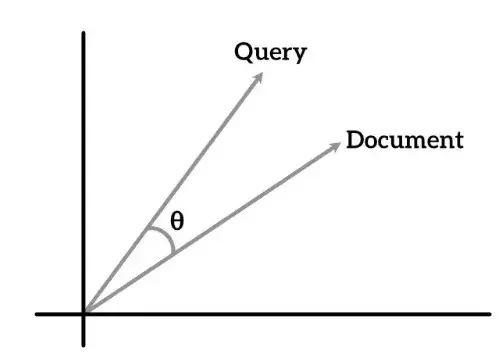
👉Using Cosine Similarity Tool to find Content Relevance between Focus Keyword and Document
- Enter a document and its focus keyword.
- Enter competing URLs to compare their relevancy with ours.
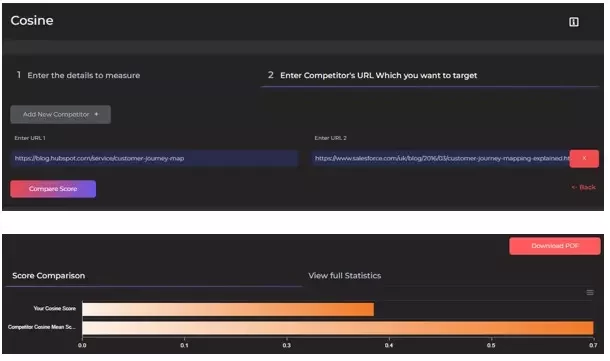
Lower our cosine angle more the relevance of the Keyword to the document.
👉Semantic Proximity and Semantic Score
Semantic proximity measures the distance between similar words or searches terms within a specific document set. It works on a different algorithm which is known as Euclidean cosine.
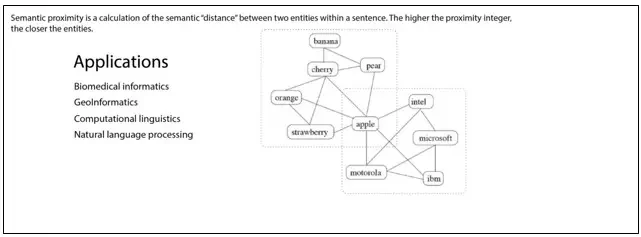
Here’s an example that illustrates its ability more clearly.
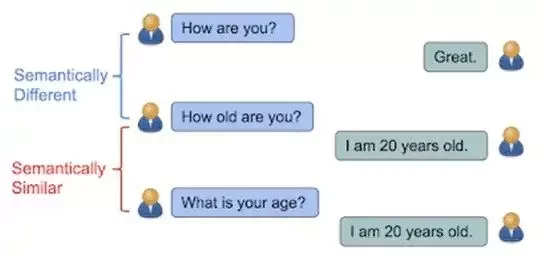
In seo, semantic proximity is very important. As per the generic rule – each of the semantic keywords within a document set should be equally spaced and balanced.
👉How to use the Semantic Proximity Tool
- Add the URL needed to be analysed.
- Then check if the landing page proximity score is less than the mean value of the competitor’s score. If our score is less than that of competitors, then our semantic proximity is optimised. Else we need to re-optimize the content to get an ideal score.
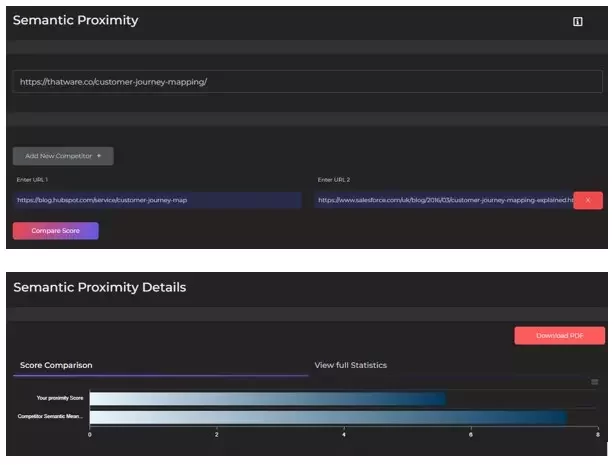
👉Semantic Score
Semantic is an overall score assigned to a keyword to validate its intent specification in search. It uses the different Semantic-based algorithms like LDA, Cosine Similarity, and Word cloud to have an overall idea of semantic relevance.
It is to be noted that having a good semantic score of your Keyword to your content is not a ranking factor. It only highlights the level of semantic relevance of your content to the target keyword which may work in favour of you since Google AI algorithms claim to populate SERPs on the basis of semantic relevance.
👉How it Works
- We take the landing page and calculate the search term’s frequency, relevancy score, and cosine similarity score by making a word cloud, LDA, and Cosine similarity algorithm.
- Then repeat the above thing for your competitor to check its score. Take a single competitor only!
- Now test for conditions. If the landing page score is greater or less than the competitors. If the score is greater than no action is needed else suggest adding the search terms on the landing page.
👉Are Keywords Still Relevant?
At the beginning of everything, there were only keywords. The idea was simple, if you wanted to rank on a particular search query it was imperative to strategically place all relevant keywords along with the target keyword in your document and voila! Based on the competition, you are sure to get a ranking.
Despite significant advances of Google in semantic search it is still safe to say that the influence of keywords is not totally dead. This is because keywords are fundamental in understanding what the user is searching for. This is a concept so fundamental that cannot possibly be eroded away.
Understanding the user’s query starts with Keywords, hence it is fundamentally imperative to have good keyword research before beginning a website.
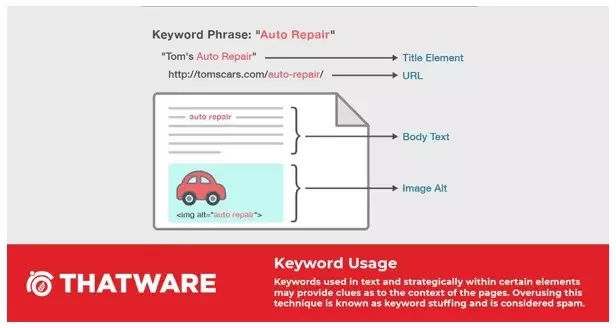
This leads us to evaluate Keyword density. Although there is no official statement from Google regarding Keyword density, it is generally a best practice among SEOs to maintain a keyword density of 2%.
However, let me warn you that maintaining a keyword density doesn’t mean using the same phrase this many times. It simply is a benchmark that can be used to include helpful semantically related keywords in your document but not to overuse it.
You can determine Keyword Density in a document using our keyword density tool.
👉Analysis:
By counting word occurrences the numbers of occurrences represent the importance of the word. More frequency means more importance. First, we tokenize each and every word in the text document then we use the tokenized words for each observation and find out the frequency of each token. After that, we can determine the frequency of a particular word which will, later on, indicate the relevancy of a keyword to a particular site.
Taking a corpus (collection of documents) which contains text related to the site, we vectorized all the words in a corpus and separated them, each and word has a value (integer) that indicates their occurrences, later on, we have created a visualisation to clear out which word stands for out the most. In the end, to get a fine anchor text from particular content we extracted the highest most frequently occurring words from the corpus.
👉Bag of Words
The bag of words model is an information retrieval model. It extracts keywords from large amounts of data. It also specifies the frequency of the keywords used in the document. In SEO, we use this model to create tags and correlate them with competitors’ tags to make use of all missing search terms as compared to competitors.
It is to be noted that if more search terms are targeted; the greater will be the SERP visibility.
👉Analysis:
By counting word occurrences the numbers of occurrences represent the importance of the word. More frequency means more importance. First, we tokenize each and every word in the text document then we use the tokenized words for each observation and find out the frequency of each token. After that, we can determine the frequency of a particular word which will, later on, indicate the relevancy of a keyword to a particular site.
Taking a corpus (collection of documents) which contains text related to the site, we vectorized all the words in a corpus and separated them, each word has a value (integer) that indicates their occurrences later on we have created a visualisation to clear out which word stands out the most. In the end to get a fine anchor text from particular content we extracted the highest most frequently occurring words from the corpus.
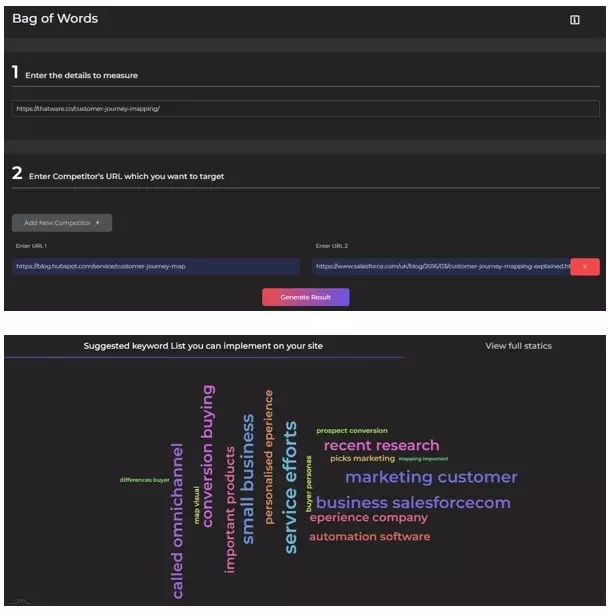
👉How does it Work
- Create a model for the landing page you wish to target and collect the top ten words by frequency.
- Repeat the process for competitors, obtaining the top 10 high-frequency words in each case.
- Combine all of the competitor’s top frequency terms to create a superset of word tags; ensure that the set is unique and that no words are repeated.
- Then compare your landing page to the final superset word and collect the terms that aren’t on your landing page.
- This will be your output: a final list of the unique terms. In other words, we’ll use this final list on our landing page to optimise the context.
👉Is Sentiment Analysis a Ranking Factor?
Googler Bill Slawski was asked the same question. This is his answer:
“Sentiment is like a flavour, like vanilla or chocolate. It does not reflect the potential information gain that an article might bring.
Information gain can be understood by using NLP processing to extract entities and knowledge about them, and that can lead to a determination of information gain.
The sentiment is a value that doesn’t necessarily reflect how much information an article might bring to a topic.
Positive or negative sentiment is not a reflection of how much knowledge is present and added to a topic.”
– Bill Slawski – Google Expert
The sentiment reflects the emotional tone of the speaker or writer of particular content. While understanding sentiment is an important aspect of understanding the context of topics and search queries, Google has always maintained the stance that it does not invoke sentiment bias in its SERP results.
Let’s take an example to back it up! Let us consider two search queries:
“are reptiles good pets”
“are reptiles bad pets”
The two queries are basically similar, “Whether reptiles are a good pet or not”. Hence considering there is no sentiment bias one would expect the same SERP or featured snippet to surface. However, the reality is far from this assumption.
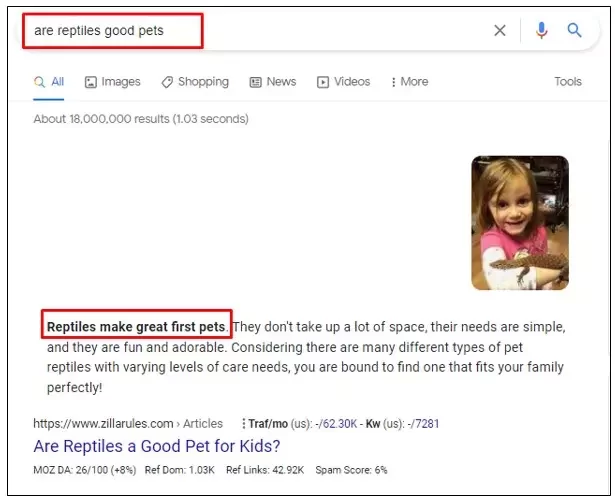
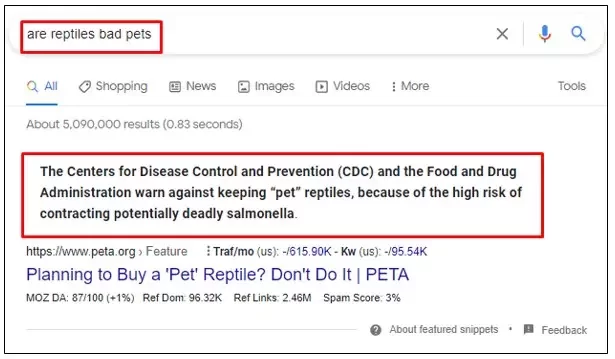
As you can see the featured snippet shown for the query “are reptiles good pets”, does not hold the same perspective as the result shown for the query “are reptiles bad pets”.
We can clearly understand from the featured snippets, that Google is ranking those pages whose sentiment, or at least the context in line with what the user is searching for. This contradicts Google’s statement.
Here’s what Google expert Danny Sullivan had to say about this:
“…people who search for “are reptiles good pets” should get the same featured snippet as “are reptiles bad pets” since they are seeking the same information: how do reptiles rate as pets? However, the featured snippets we serve contradict each other.
A page arguing that reptiles are good pets seems the best match for people who search for them being good. Similarly, a page arguing that reptiles are bad pets seems the best match for people who search for them being bad. We’re exploring solutions to this challenge, including showing multiple responses.”
The point is Google is exploring to show multiple solutions.
👉 So how do we analyze the Sentiment of Content?
The best way is to use a sentiment analysis tool. At Thatware we have developed a tool which identifies the different types of words in your document based on sentiment, (positive, negative and neutral).
On the basis of that, it provides an overall sentiment score for your content.

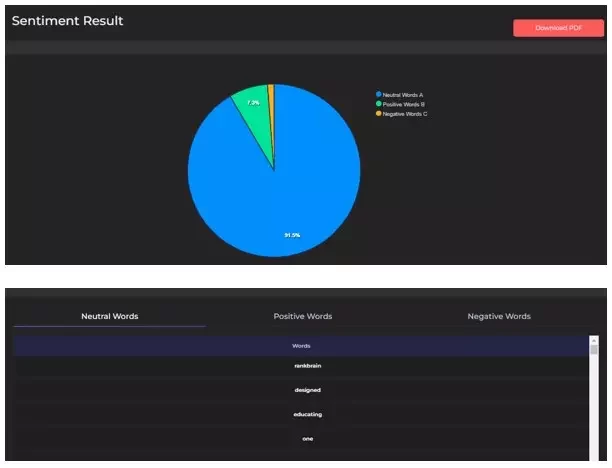
Entity Salience
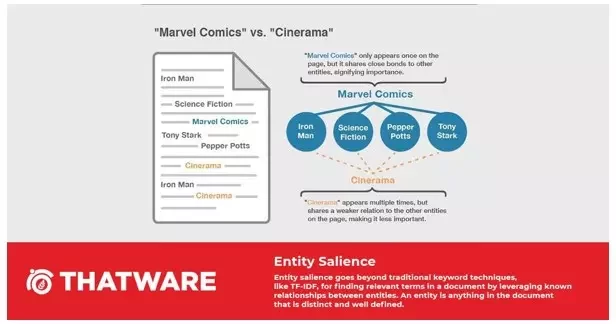
We have already talked in the previous passages about how Google recognizes entities, since the advent of the hummingbird algorithm, as opposed to keywords. Google’s priority has always been to best understand the context of search queries.
One way Google does that is through a technique called entity salience.
The entity salience technique goes well beyond the scope of traditional techniques like TF-IDF to find relevant keywords or phrases in a document by using the existing relationships between different entities.
The best way to find its significance is by using Google’s Knowledge Graph API.
When you type a query let’s say “Marvel” it returns a set of entities and assigns a confidence score also known as the salience score.
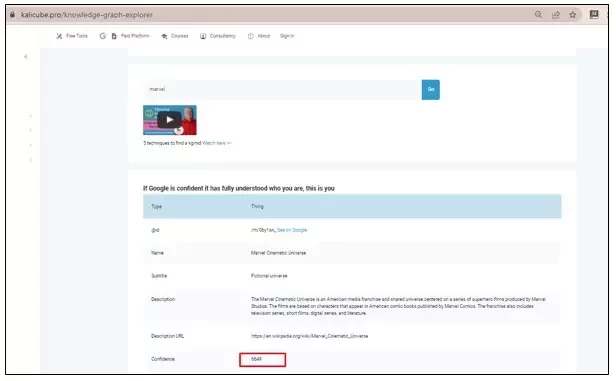
Although Google never defined Salience Score, here is what we think it measures:
- How confident Google is that this is the entity we are referring to with the query (i.e., has it matched the string of characters to the entity).
- In the case of ambiguity, which entity is the most probable candidate according to Google’s perception of intent.
- In the case that it is not the entity that corresponds directly to the query, how close the relationship is between the entities.
It is to be noted however that these salience scores do not indicate that Google uses these to build SERP. Remember Google uses a combination of 201 ranking factors and perhaps other signals to build its SERP for each query.
👉 What SEOs Can Do?
From what we have learned above we can attribute Salience as a kind of authority score. So naturally the Goal of our SEO efforts to gradually improve the Salience Score over time.
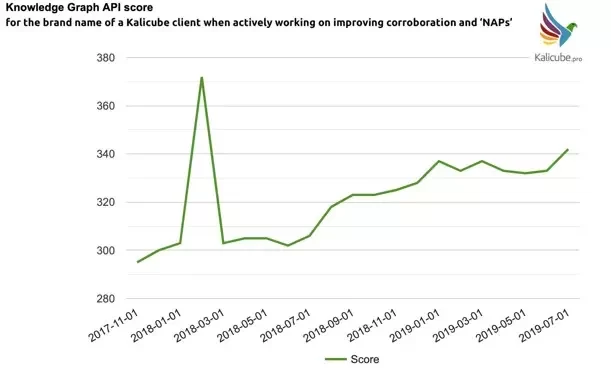
This is in accordance with Google’s EAT Guideline where salience scores tend to the trustworthiness of a brand or content. This is how we think salience scores can be increased.
- Through research and our experience, we have found that brand salience scores increase with more references. Hence Backlinks and similar signals like Social Presence and amount of searches must influence the salience score.
- Also, salience scores are easily swayed by fresh popularity.

Thatware | Founder & CEO
Tuhin is recognized across the globe for his vision to revolutionize digital transformation industry with the help of cutting-edge technology. He won bronze for India at the Stevie Awards USA as well as winning the India Business Awards, India Technology Award, Top 100 influential tech leaders from Analytics Insights, Clutch Global Front runner in digital marketing, founder of the fastest growing company in Asia by The CEO Magazine and is a TEDx speaker and BrightonSEO speaker..


